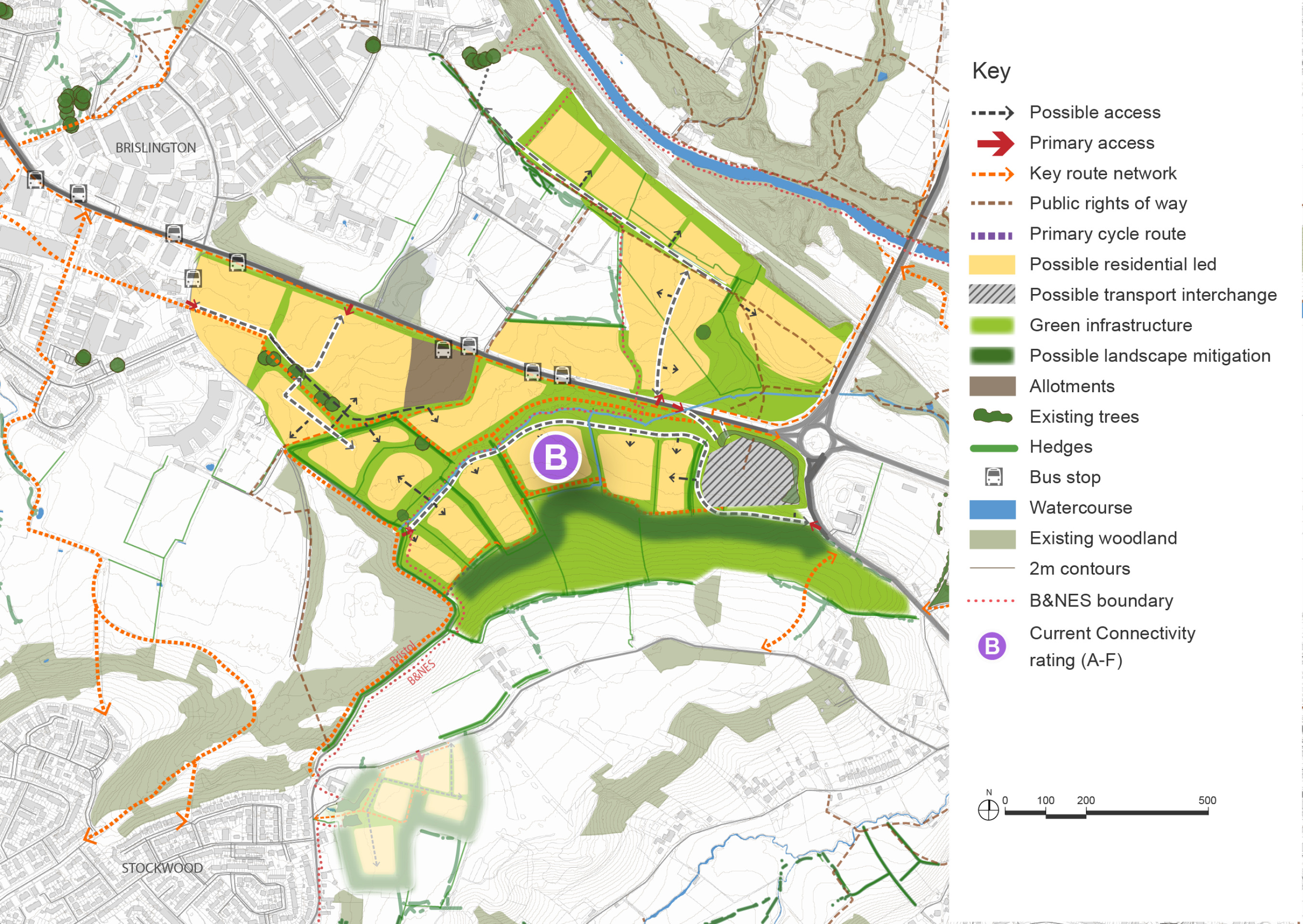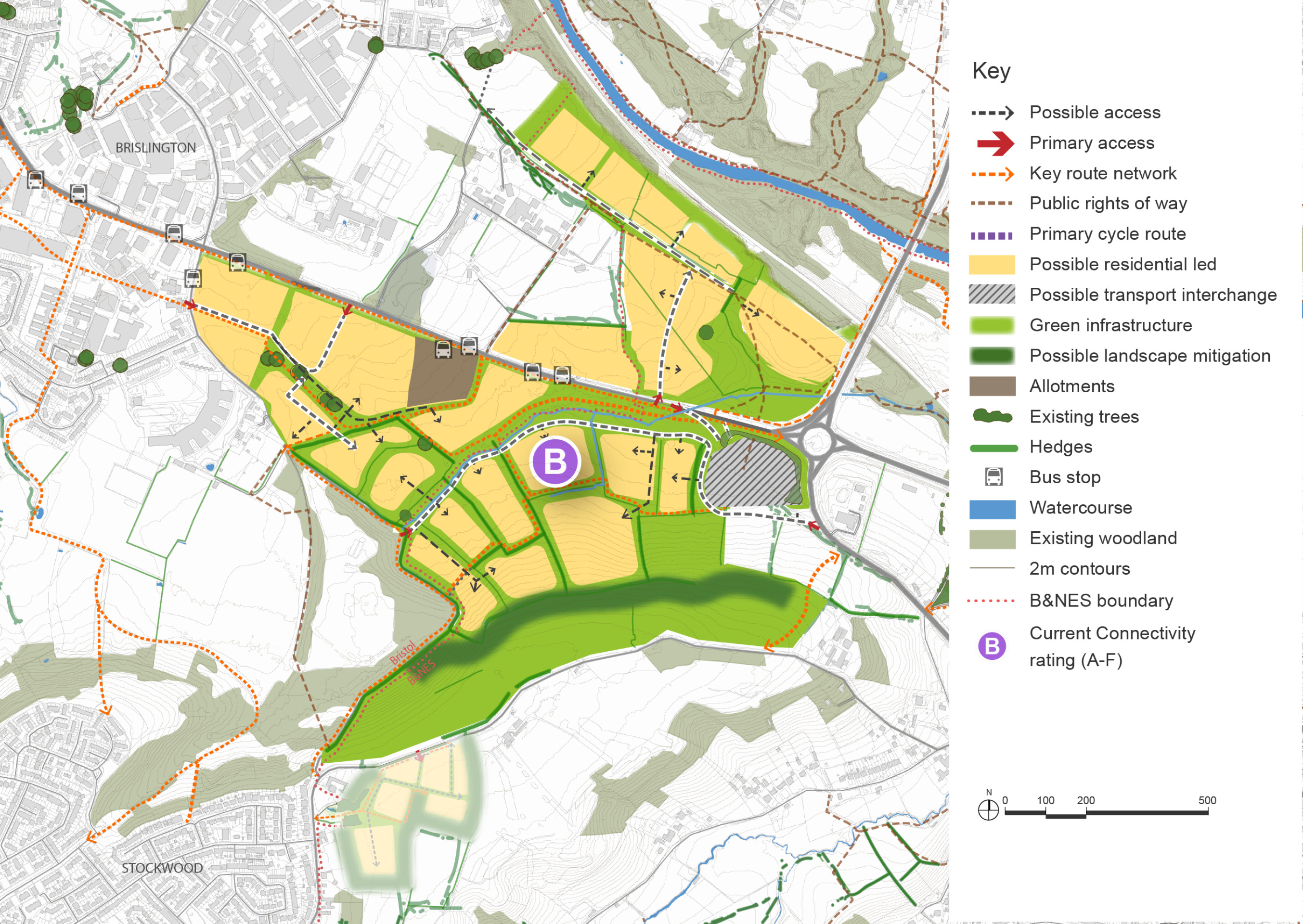Context
Two options are proposed which are broadly similar, but with one option providing more development to the south than the other. Option 1 contains the landscape mitigation required within the same landownership and Option 2 requires third party land to deliver the landscape mitigation.
Both options seek to optimise development capacity and densities in the area whilst ensuring that a sufficient Green Belt gap between the Hicks Gate area and Keynsham is retained and enhanced.
Subject to the completion of further evidence relating to the Green Belt, and to further evidence relating to the Hicks Gate Interchange, specifically the amount of land required for delivery, there may be the opportunity for further development to the south and south east of the proposed Transport Interchange shown on both options.
It should be noted this area has primarily been considered as a residential led development, with the opportunity for employment led regeneration within the Brislington Retail and Trade Parks. This area is within Bristol City Council’s jurisdiction and any proposed changes will be in their own local plan or other regeneration initiatives. However, as set out in chapter 3 above there is a need to plan for additional employment space within Bath and North East Somerset in order to help facilitate a more prosperous, sustainable and fairer economy and this location may have the potential to accommodate employment uses.
Therefore, an issue to be considered for these options is whether there should be a section of the development area within Bath and North East Somerset that is focused on the provision of employment floorspace. This would rebalance some of these development parcels and provide a greater proportion of employment and less housing development. A logical location for an employment element could be adjacent to the proposed Hicks Gate Interchange.
Hicks Gate Option 1 – Indicative plan

Click to enlarge
Hicks Gate Option 2 – Indicative plan

Click to enlarge
Site Option – Key information
| Element |
Description |
| Development opportunities |
- The delivery of a vibrant, well connected, higher density, low carbon community, within a high-quality, nature positive, urban environment that is in harmony with its attractive landscape setting. It will be an exemplar for sustainable living and working, providing new approaches to sustainable transport, with high levels of public transport and active travel use. It will have integrated green and blue infrastructure, rich in biodiversity, and unlock improvements to the quality and accessibility of the surrounding countryside.
|
| Constraints |
- Located in the Green Belt.
- The A4 corridor is an important strategic transport corridor into Bristol and can get congested.
- Both options propose development in areas of landscape sensitivity. In Option 1, all land, including the area for landscape mitigation, is within the same ownership. Further assessment is required to ascertain whether the proposed landscape mitigation at the southern edge in Option 2 is deliverable, as this would be on land owned and controlled by a third party.
- Secondary school pupils within B&NES would need safe access to Broadlands in Keynsham.
- Delivery requires co-ordination between B&NES and Bristol City Council. It will be crucial for the local authorities to collaborate to enable the preparation of a comprehensive masterplan and the delivery of social infrastructure to deliver a high quality place to live and work.
|
| Mitigation |
- Careful consideration of the location, accessibility and integration of bus stops on the A4 to optimise public transport use by residents. Pedestrian and cycle crossings will be required over the A4 to alleviate severance issues and allow access to public transport.
- Significant green infrastructure and planting required throughout and along the edge of the development sites. An area to the south has been identified for landscape mitigation, but this area is in different ownership to the main area proposed for development and delivery of this landscape mitigation is uncertain and based wholly on the consent of the landowner. If this is not deliverable, then appropriate landscape mitigation must take place within the proposed development area and the overall quantum of development will be reduced.
- Seek to make improvements, including enhanced access, to the remaining Green Belt land, providing opportunities for outdoor sport and recreation, retaining and enhancing landscapes, visual amenity and biodiversity.
|
| DfT current connectivity rating |
|
| Further evidence required |
- Green Belt assessment required to further assess the impact of removing land from Green Belt, including cumulative impact when considering strategic removal across the district.
- Landscape sensitivity assessment and mitigation
|

